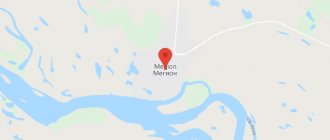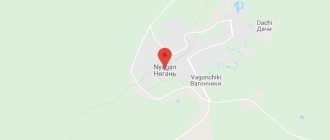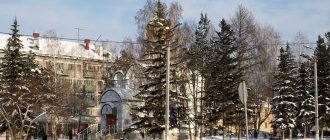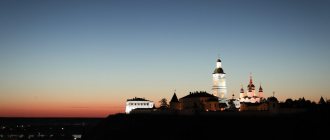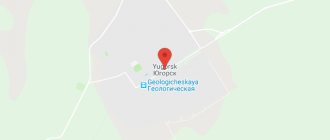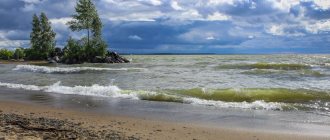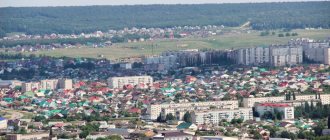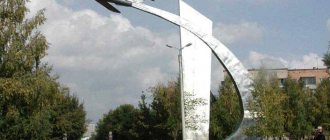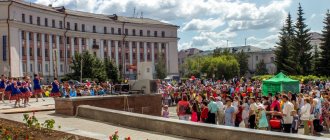Marked on the map of Russia, Leninsk-Kuznetsky is a city that grew up on the largest coal deposit. The first mention of it dates back to 1763. But in those days it was not yet a city.
The current Leninsk-Kuznetsky from 1763 to 1922 was called the village. Kolchugino (given in honor of a Russian settler), and in the period from 1922 to 1925 it was called the village of Lenino. Today, over 96,000 people live in the settlement, according to the population census at the beginning of 2022.
General information and history of the city
Leninsk-Kuznetsky is located in the west of Kuzbass (a natural geographical landmark is the center of the Kuznetsk Basin), about 100 kilometers south of Kemerovo.
The history of the city can be counted from the moment when coal outcrops were found near the village of Kolchugino (80s of the 19th century). Almost immediately, a working settlement was formed here, on the banks of the Inya River. However, before the revolution, little coal was mined, and only a few dozen people permanently lived in the mines. Serious development of the deposit began under the new government - in the 1920s. 1922 is the date of renaming Kolchugino to Lenino. And in 1925, the village of Lenino officially became a city. The name "Leninsk-Kuznetsky" was chosen to distinguish the new formation from several other "Lenins" that appeared in Russia in the first post-revolutionary years.
During the Soviet period, the city gradually grew, coal production grew steadily, and in 1989 the city of Polysayevo was separated from Leninsk.
See also[edit]
- Book of memory of miners of Kuzbass/Leninsk-Kuznetsky
| [ + ] Leninsk-Kuznetsky - a city of miners | |
| Perm region | Gremyachinsk • Gubakha • Kizel |
| Primorsky Krai | Partizansk • Artyom |
| Komi Republic | Vorkuta • Inta |
| Rostov region | Gukovo • Donetsk • Zverevo • Novoshakhtinsk • Shakhty |
| Tula region | Venev • Lipki • Nelidovo • Novomoskovsk • Uzlovaya |
| Chelyabinsk region | Bakal • Emanzhelinsk • Kopeisk • Korkino • Plast |
| Ghost towns | Kadykchan • Halmer-Yu |
Climate and ecology of Leninsk-Kuznetsky
In winter it is very cold in Leninsk, and in summer it can be unusually hot. Actually, the sharply continental climate that dominates the entire territory of Kuzbass makes all cities similar in this regard. If you have ever been to Kemerovo or Novokuznetsk, you know what to expect from Lenin weather.
The environmental situation is unfavorable. The Inya River, on which the city stands, has become significantly shallower over the past two decades, and fish stocks, once significant, are now minimal. This is primarily due to the development of coal deposits, accompanied by abundant industrial discharges into the river, water intake for technological needs, etc. Ecologists say that the bottom sediments of Ini are now largely technogenic in nature.
The mines have a negative impact on both the cleanliness of the air and the “general impression” of the surrounding space - in winter in Leninsk you see black snow too often. Boiler houses operating exclusively on coal also contribute.
Household waste dumps are probably the most minor problem. At the very least, city services are coping with garbage removal, and the landfill located in the industrial zone has not yet exhausted its resource.
Entertainment complex "Pobeda"
The cultural and entertainment life of society includes cinema, billiards and other entertainment. The first place for leisure is considered to be the Pobeda cinema. Built in 1938 this cinema was completely renovated in 2001.
Today this establishment has the status of an entertainment center. Having an excellent location in the central part of the city, Entertainment is very popular among citizens.
The complex includes not only a cinema with a cinema hall with 225 seats, but also a billiard room with bowling alley and a cafe.
Location: Kirova Avenue - 34.
Population of Leninsk-Kuznetsky
The city's population is steadily declining. The increase was observed until perestroika (the historical maximum was more than 165 thousand inhabitants in 1989). At the same time, Polysayevo was separated into a separate city - the sharp decline in 1989 was associated precisely with this and can not be taken into account in assessing the situation.
Lenin Avenue
But from 1992 to the present day, the number of Leninsk-Kuznek residents has fallen by more than 20 thousand people (now just over 99 thousand people) - a serious indicator for such a small city.
The unfavorable economic situation in the 90s, traces of which can easily be found now, difficulties with raising children (it is difficult to get a good education in Leninsk itself), and the lack of prospects for young people are the main reasons for the migration of city residents to the relatively prosperous Tomsk and Kemerovo.
The mortality rate is high, and the birth rate increased slightly even in the “well-fed 2000s”. Let's look at the statistics again. In 2001, 20 thousand children studied in thirty-five schools in the city. Already in 2005, there were 26 schools, and fewer than 12 thousand students. Talking facts.
Almost half of the residents are people of retirement age, more women (miners, as a rule, do not live to old age). The demographic situation is aggravated by widespread drunkenness. Vodka is popular among older people, beer among the younger generation. Perhaps the main problem is that a person’s environment from the first years of life contributes to the development of bad habits - the traditions of “gop culture” are strong in Leninsk.
Actually, the most common types in the city are the “gopnik”, the hard worker (this type is often combined with the first), and the pensioner. There is a thin layer of “informal youth” - Rastafarians, fans of alternative music, rockers, and a slightly less thin layer of intelligentsia (mainly teachers).
Museum of Local Lore
The museum was founded in 1934 and is a historical treasure of the city. Here there is a unique opportunity to visually learn about historical events. The main reason for its occurrence is the extensive accumulation of historical monuments and antiques. Having authentic collections of events from past years, the museum is of particular value. The exhibition is dedicated to the city’s participation in the Second World War and is shown in the local history museum in the format of chronicles and rare volumes.
Location: Kirov Avenue - 51.
Districts and real estate of Leninsk-Kuznetsky
Officially, the city is not divided into large areas; the map of Leninsk is a set of residential microdistricts (they are concentrated in the northeastern part of the city), and “near-mine” villages.
3 microdistrict
Plus the city center, which most closely resembles a civilized city. In the north there is an industrial zone. However, this does not mean that there are no mines in other parts of the city; only the northeast (well, and the so-called center) is considered “coal-free”.
The unofficial geography partially follows the official one, but the most odious areas of the city, of course, have popular nicknames. First of all, it is worth noting the areas that, from the point of view of an ordinary person, are unsuitable for life - the crime rate, which is already extremely high in Leninsk, is considered simply off the charts here. And if this fact is not particularly noted in the Internal Affairs Directorate reports, it is only because “strangers try not to come here,” therefore, the number of statements is much lower than the real number of offenses. After all, it is not customary to write statements about “squeezed cell phones” in your area - in a police environment, an informer is automatically transferred to the most despised “subclass” of people – “reds” (however, more about crime in the corresponding section).
So, the three most disadvantaged areas of the city:
- the Central Market area (markets in residential parts of the city in general often become habitats for various kinds of marginalized people, Leninsk is no exception);
- “Seven” (village of the “Seventh of November” mine);
Seven
- “Tenth Precinct” (ironically, the city mental hospital is located here; some Leninsk-Kuznek residents believe that the space inside and around the hospital fence does not differ much in terms of the level of development of the population).
Tenth precinct
However, each resident of Leninsk will make his own “top” of the most terrible places - there is no shortage of areas in the city that meet the criteria. The only advantage of moving to these areas is fairly cheap housing (a private house connected to a water supply can be purchased for an amount not exceeding 500 thousand rubles). A one-room apartment will cost a little more – up to 700 thousand. At the same time, many good people live here, but this is rather due to the inability to leave and the force of habit. And yes, houses like the ones in the photo below are very rare.
In general, cheap houses are on sale in all villages within the city, be it “Komsomolets”, “November 7th” or “Dachny”, but living in them is associated with certain difficulties. In addition to the high crime rate, widespread drunkenness of residents, bad roads, there is also a lack of infrastructure necessary for civilized life - you can forget about hot water from the tap, there is no access to the sewerage system.
The geographical and unofficially recognized center of the city coincide - it is a conventional area around the only entertainment center. Registry office, administrative buildings, good shops, cafes. If you are moving to Leninsk, then it is worth living here or in microdistricts in the northeast - fortunately, new residential buildings are being built.
Apartments in both places are expensive by Lenin’s standards: a one-room apartment can be bought for 800-900 thousand, a two-room apartment for two hundred million, a three-room apartment for one and a half million. At the same time, interesting offers sometimes appear on the secondary market - apartments in less than perfect condition for a price 10-20 percent lower than the market average. As a rule, such purchases are justified - repairs in Leninsk will not bring large expenses (workers value themselves much cheaper than is customary in large cities).
Chapel "Joy of All Who Sorrow"
A small marble chapel with a gilded dome became a decoration of the city center. It was installed in memory of the murdered miners.
The first prayer was performed in 1999 by Archbishop Sophrony. This event was observed by the widows of miners with children and about two thousand townspeople.
The book, specially prepared for this event, is biographical in nature. About 1,500 destinies of miners were described in this book, their lives lived and pain at the Kuzbass mine.
Location: Kirova Avenue - 37a.
City infrastructure
Roads in Leninsk have at least some kind of marketable appearance only in the center and in residential areas. In some places (especially in villages within the city) the road network is in poor condition. At the same time, in some places in the center the asphalt is laid simply perfectly - one of the sad paradoxes of the city.
On the positive side: there are no traffic jams here. Which is not surprising, given the size of Leninsk.
Housing and communal services tariffs, as elsewhere in Russia, are growing rapidly. For example, in 2011, some categories (sewage, hot water supply) grew by 20%. Situation in autumn 2012:
- heating - 21.02 rubles per square meter of area (taking into account the standard of payment), or 32.34 rubles per square meter (in the amount of 100%);
- hot water – 76.77 rub. per cubic meter (“Vodokanal”) or 49 rubles per cubic meter (FGLPU “NKTsOZSH”);
- cold water – 18.49 rub. per cubic meter;
- water disposal - 12.86 rubles. per cubic meter;
- electricity – 1.62 rubles. per kWh or 2.31 rub. per kWh (if a stationary stove is installed in the house/apartment).
The provision of transport is acceptable - not only buses, but also trolleybuses run in Leninsk. You can get to Kemerovo or Tomsk either by intercity bus or by train.
There are relatively few problems with kindergartens in the city. Despite the fact that nine kindergartens have closed since the beginning of the 2000s, more than half of the children of the corresponding age attend the remaining thirty preschool education institutions. The problem of lack of places is mitigated by the fact that a significant part of the city’s female population are housewives.
There is no shortage of secondary schools, but parents with slightly above-standard education have limited choice: only two gymnasiums and one lyceum.
Future athletes are trained at the children's and youth sports school, and gymnasts/gymnasts at the Mametyev Sports and Youth Sports School. The city also has a music school, a palace of creativity, a house of technical creativity and a center for further education. The people working there really do everything that can be done in such conditions, but this does not save the situation as a whole - it is very difficult to provide a well-rounded education for a child in the city.
Alley of Miners' Glory
This very interesting and memorable place became the property of the city in 2002 on Miner's Day. The common people call it more simply - miners' alley. Several memorable dates were dedicated to the opening day. This is the fiftieth anniversary of the miner's day, the sixtieth anniversary of the formation of the region and more than a hundred years since the founding of the mine itself.
Interesting sculptures in the form of trolleys commemorate the mining town. The stele - a pile driver, in the center of the memorial, symbolizes the hard work of the miners. The restoration of the alley took place in 2008, adding and updating its appearance. The stela-koper characterizes the 125th anniversary of the mine and the production of the billionth ton of coal.
Enterprises and work in Leninsk-Kuznetsky
The city's economy is, of course, based on coal mining. Mine named after Kirov, mine named after. November 7, mine named after. Yaroslavsky, “Komsomolets”, “Kolchuginskoe”. The life of miners here is no more fun than in other cities (in Kuzbass, there are really “stupid” salaries only at Raspadskaya in Mezhdurechensk). A monthly salary of 20 thousand rubles or more is the prerogative of miners working in the face; other mine workers receive less.
Kuzbasselement produces batteries - at this plant you can earn up to 15 thousand a month. If, of course, they can be obtained at all. In 2009, the owners of the enterprise disappeared, leaving unprofitable production and wage debts - now the situation has normalized a little, but it is clearly too early to add Kuzbasselement to the white list.
Women can get jobs as workers at a worsted cloth factory (salaries are symbolic - up to 10 thousand) or go to the service staff (sales consultants and waitresses in some places earn more) - to Travelers or the Chamber. However, good vacancies in the service sector appear extremely rarely.
Shopping center Fabrika
Insufficient infrastructure development makes the city attractive for entrepreneurs. A person who opens, for example, an interestingly designed and inexpensive cafe in a residential area in the northeast can count on a good profit. Another thing is that fighting constant checks, the greed of officials, and crime is a matter for strong-willed people. But for people associated with local authorities, only good luck awaits them in business - amazingly lucky ones (I note that this paragraph consists mainly of guesswork - in no way do I want to offend the officials of this glorious city).
The city's doors are open for representatives of well-known networks. But if you do not own Apricot or, say, Euroset, you need to think very carefully about the prospect of starting a business in Leninsk. Especially considering the information in the next section.
Square of heroes of the Kolchugin uprising
The event of 1919 turned Soviet history upside down, playing a significant role in the imbalance of Kolchak’s rear and the establishment of Soviet power.
The monument was erected in 1957. The event of April 1919 claimed the lives of hundreds of miners. 600 people were shot here.
This is a kind of mass grave. On the front side of the obelisk there is an inscription: “To the Heroes of the March Uprising.”
Some changes and additions were installed in 1985. This memorial is protected because entered into the Unified State Register of Cultural Heritage of National Significance.
Crime
We can talk about crime in Leninsk-Kuznetsky for a long time. An indicative point: the area of Victory Square (this is the city center, the registry office is located nearby) in police reports is equated in terms of crime level to the depressive area of the Zakamyshan hospital. In practice, this means that you can be robbed anywhere: even if you are walking along the main street in the evening, it is reckless to feel safe.
Situations are still possible in the city that residents of many regions have already forgotten about. The seizure of Ursa Bank in 2009 caused a wide resonance. A man armed with a firearm took five people hostage. He demanded the release of his friend from prison, a round sum of money and a plane. It is noteworthy that the governor himself went to negotiate with the invader, but everything ended according to a harsh scenario: riot police killed the criminal during the seizure of the building. The hostages were not injured.
However, some cases are of interest not because of the scale of their villainous acts, but because of their almost cartoonish comedy. In the summer of 2012, a healer was detained in Leninsk for “treating” clients by taking gold and jewelry from them (allegedly in order to sanctify them). The jewelry ended up in a pawn shop. And the would-be healer (a drug addict, by the way) received three “suspended” years in prison.
It is somehow not customary to remember the era of the 90s in Leninsk. Probably because the criminal component of city life has changed little. In Leninsk, random interlocutors, as of old, talk about how “half of the city is held” by K***. And they remember that some time ago another authority was widely known (with a surname also beginning with K), but after the “showdown” that ended sadly for him, he left for Novokuznetsk. Yes, they don’t shoot in the streets like in the 90s. But in fact, little has changed. First of all, the thinking of the townspeople has not changed.
St. Seraphim-Pokrovsky Monastery
The city's stone church with beautiful architecture today is associated with a convent. The history of this monastery begins in 1852. After a series of reconstructions, it was decided to build a new church. The basis for the construction was the formation of a convent. The 1987 decree documented and registered the Orthodox community at the Intercession Church. The opening took place in April 1992.
Location: Sovetskaya street - 187.
Monument to twice Hero of the Soviet Union A.P. Shilina
This monument is dedicated to the events of the Second World War and was erected in 1953. This monument was erected in honor of the twice awarded hero A.P. Shilin.
Afanasy Petrovich was an honored Hero of his time. His exploits made an enormous contribution to the victory of the Russian people over fascism. We must remember this and give thanks for the peaceful sky above our heads. Walking near the bust of memory of them. Shilov, remind us of the heroism and unbroken character of Russian soldiers.
Memorial to fallen heroes during the Great Patriotic War
The memorial monument has a unique structure, consisting of three separate parts. On the one hand, the memorial has an Eternal Flame and a weapon in the form of a cannon. Nearby there is a stone Order of the Second World War. In conclusion there is a bust of A.P. Shilin.
This building is an eternal memory of those who died for the sake of victory. Thousands of soldiers went to fight and never returned. The main historical monument is installed on Victory Square with the words: “For valor in battles, for feats in labor - the townspeople are grateful to their fellow countrymen.”
Monuments to fallen heroes are located near the mines and are immortalized with memorial plaques, and the streets are named after fallen miners.
